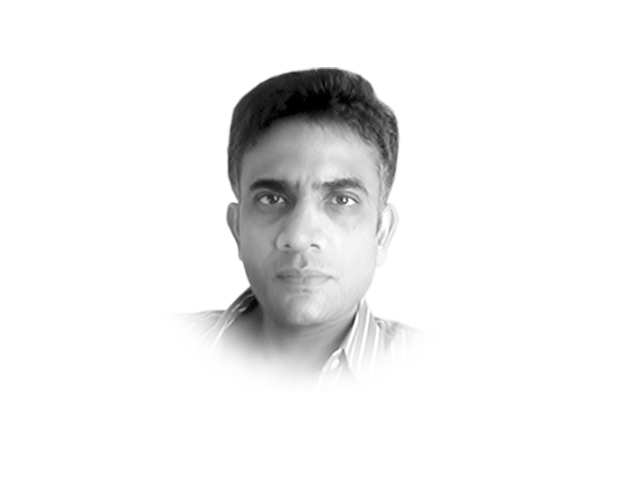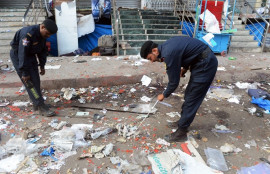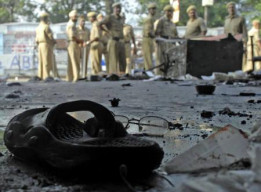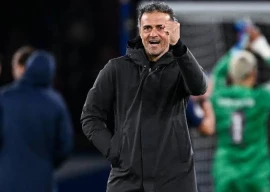
In the eight years the Congress has governed India, terrorism has declined each year, according to data from KPS Gill’s South Asia Terrorism Portal (SATP). Deaths from terrorism have fallen from 3,259 in 2005 to 804 last year. The other aspect is that almost all of these deaths are from Maoist violence and from army operations in the northeast and Jammu and Kashmir (J&K), not violence, by what are called Islamists.
And even in these three areas, the number of Indians being killed is in sharp decline. Deaths in Maoist violence were 367 last year (of whom 117 were terrorists, according to SATP). This is down from 602 in 2011 and 1,180 the year before that.
J&K saw 117 deaths last year (of which 84 were terrorists), down from 183 in 2011 and 375 (including 270 terrorists) the year before that. The problem area is the northeast, which we don’t usually think of when we say terror because it is so violent all the time. Here also, the trajectory of violence is downward. The number of deaths are 317 last year (including 209 terrorists), 246 in 2011, 322 the year before that, 852 in 2009 and 1,051 in 2008. The most violent state in India is actually Manipur, and most of the “terrorism” related deaths there are from exchanges between army and militants.
The last full year Atal Behari Vajpayee was in power, 2003, as many Indians were killed in terrorist incidents (3,702) as the total for the last three years under Manmohan Singh. How many times have you heard that said before?
This is even more remarkable when we learn that the figures under the Bharatiya Janata Party (BJP) excluded all Maoist violence because that wasn’t compiled under “terrorism” till 2004, when Singh came to power.
Now let us turn to Islamist, Hindutva and other terrorist attacks in our cities. This is the subject the media has been writing and broadcasting about since the Hyderabad attacks, a few days ago. How unsafe are our cities?
Outside of the three areas that we looked at, the total number of Indians killed in all the other states of India is already low and it is falling.
Last year, there were only three deaths (all three terrorists, no civilians) from terrorism in India. That is fewer than those killed from terrorism in the United States that year. In 2011, there were 42 deaths in India, in 2010 there were 25, and only eight in 2009. To put this in some perspective, last year, there were 6,211 deaths from terrorist violence in Pakistan, including the killings of 3,007 civilians and 732 security forces personnel. That wasn’t exceptional and there were 6,303 deaths the year before that, and 7,435 the year before that.
Pakistan is exceptional. But in all the nations of Western Europe, whose combined population is 400 million, or one-third of India’s, the total number of fatalities in terrorist incidents in 10 years after 9/11 was 439. This is not too different from the number for India, excluding those three areas that are disturbed, and even there, as we have seen, India is becoming more peaceful every year. It is correct to say that Indian citizens are as safe as the citizens of Europe and America against Islamist terrorism. You would think that a performance so demonstrably successful would earn Manmohan and his team applause. Instead, we have the inane commentaries that issue from a media that is convinced the Congress is doing something wrong here.
The numbers indicate that the Congress government is doing something spectacularly right, and it was actually the BJP that was soft on terror.
After the violence of 2002, in Gujarat, there began a spate of attacks against Gujaratis in Bombay. There were bombings in Zaveri Bazaar and Ghatkopar. The man investigating these, Rakesh Maria, told me then that the attacks would continue for a very long time. He worried that because there was such anger among Muslims for what was happening in Gujarat, ordinary people were taking to violence. But this violence soon stopped.
It did because there is also another side to India, the larger side, which is inclusive and secular. It cancelled out the viciousness of Gujarat, and it always will.
Published in The Express Tribune, March 3rd, 2013.
COMMENTS (31)
Comments are moderated and generally will be posted if they are on-topic and not abusive.
For more information, please see our Comments FAQ











































gp65, get a life.
@MSS: You are right that while the laws were always secular, the Indian polity is increasingly becoming so. The patience for those spreading fear and hate of the others is reducing. This is a good trend. While there will always be some bigots in beery society, the important thing is to not tolerate acts of bigotry. But this is not a 8 year trend asaakar tries to portray. But has been ongoing over the last 3 decades.
@gp65: your last line summed it up.I think swapan dasgupta very rightly says about these pseudo secular be it justice katju,aakar patel,rajdeep sardesai,barkha dutt it may be press council chairman or these paid journalist these guys are desparate to add gujarat in each and everything hurrah to the competence of mr patel his last line made him look like an idiot.
Despite disagreements, I'd say the stats are well put up but what we PAKISTANIS have to learn from this article? What if you compare BJP with Mullah parties in Pakistan while congress with PPP or PML.
Akaar is obviously doing what he can to ensure BJP does not come in 2014. There is no love lost between him the Modi clan However, there is truth in what he is suggesting. The point he is making is that the numbers dying is gradually declining. Terrorist lead violence is coming down whether it was Muslim, Hindu, Sikh or any other type of terrorism, it is declining. There is no need for statistical accuracies and tests. Leave aside Godhra and 1984 things are improving in India.
@Razi: I would not defend Modi if I believed he was responsible for the riots. I do not however believe that. Nor does the Supreme court of India. HE has governed for 11 years without riots. Even in the Feb 2002 riots, he had called the army on day 3 after which riots stopped. If Modi is a murderer, then there is NO political party leader in Pakistan who is not with ongoing target killings and sectarian killings. As far as Muslims in Gujarat are concerned they have started voting for him because poverty level of Gujarat as a whole is 20% and poverty level of Muslims in Gujarat is 13% which shows that they do not face discrimination in Modi's Gujarat. These numbers by the way are not fudged numbers by Gujarat government but by Congress run Planning commission.
And I am not an apologist for BJP, I am a BJP supporter and I feel there is nothing to apologize in supporting a well governed party as compared to supporting dynastic rule.
But coming from a country where the constitution itself is communal, where all decisions are measured based on whether they are right or not per Islam, you are a fine one to speak about BJP's non-existent communalism.
Akaar Patel,
Your memory is anti-BJP. The biggest terror toll was during Khalistan movement in north India. You do not want to remember or talk about those thousnds of Hindus and Sikhs killed during that period of Congress regime in the center and state (president's rule is indirectly by the center)
But we do not expect the whole truth from you becasue of your leanings towards corrupt congress.
@John the Baptist: Ha, Ha - as if the superstitious beliefs in Christianity are totally evaporated from Europe after Rennaisance. There may not be lynch mobs or burning of people on stakes due to religion like Jews etc, but the superstition persists. There may not be fights between Lutherans, Protestants and Catholics and the superstition may not be visible on surface but it is plentiful. It may not be debated or even practiced at times but belief in it is not given up. How can that be proven, well you may ask. So, I think, just follow the next election of Pope which is coming soon on your TV screen and question yourself if in that elections some superstitions are followed or not. Remember fight over religion in Northern Ireland is just dormant at present but there is overwhelming fear of Islam in Europe otherwise Turkey would have become part of EU by now. Think about condoning the paedophilia practiced in Churches not only across Europe but in US too. What about fighting over Gay Marriages. What about allowing women abortion in Ireland or stem cell research using foetus. But unlike you, I do not want to feel smug. I know that every body and society is moving in the right direction with the time. It may seem that it is not moving but it is moving. Thus even Islamic societies are either moving or looking to move just like Christian and Hindu ones are.
Its always a depressing scenario to read the comments of people on this site. The only solace is that it is depressing-lite after reading through the Hindu.......
@gp65
You are a real BJP/RSS apologist. In fact that's what most Indians commenting here and on their own newspaper websites are. No qualms defending murderers, communalists and bigots. Yet this woman is providing us Pakistanis with a new perspective that she is so proud to do, day in and day out, 24/7, from her high moral and intellectual ground.
The writer has not taken into consideration the dynamics involving the 1.Numerous bomb blasts & terrorist incidents (2006-2008),- The bloodiest in Indian history 2.Political pressure on the Congress after 26/11, 3.Drone strikes on the training camps of Pakistan, 4.International pressure on Pakistan to stop supporting terrorism as a state policy especially after 2008, 5.And finally a better funded border & sea patrol after 26/11 to be the actual cause of this reduction. Numbers can be twisted to prove anything......Readers are advised to view the article from a different perspective.
There are other statistics also regarding communalism
790 Musims and 254 Hindus died in post-Godhara riots, 2500 Sikhs died in post Mrs. Gandhi assassination.
11 years of riot free rule under BJP vs riots in Maharashtra, Assam and UP (part of UPA).
Yet NDA is communal and UPA is not?
Why violence of Gujarat is mentioned in this column when we are comparing statistics of Terrorism. quote wikipedia " 790 Muslims and 254 Hindus were ultimately killed and 223 more people were reported missing. ",
"because there was such anger among Muslims for what was happening in Gujarat, ordinary people were taking to violence" - By the same token, why there were no retaliation for 254 Hindus killed in Gujarat riots instead according to author, they showed inclusiveness and secular character. Gujarat riots is blown out of proportion for political convenience even now, though there are no single incident since 2002.
Akaar Ahmed Patel for the decrease in terrorist attack in India one must give credit to Atal Behari Bajpai of the BJP who used diplomatic, military and moral pressure on Musharraff to declare on the TV for internation audiance that Pakistan soil will not be used against any terrorism in India. Of course by that time the plan to fence the LOC was in full progress. The tcross border errorism does not go away overnight; it tapers off and the results are with all to see.
Additiionally, the inner turmoil between the Pakistan establishment and Jehadi outfits diverted their resources in creating truoble inside Pakisatn from 2004 onwards. The case in example of the army action in Swat valley. I know you are BJP basher but give the credit what was done by NDA during their 5 years stay in power in Delhi. Maun Mahan Singh is the beneficiary by default. Once BJP was out of power in Delhi, all psudo-secular forces (for example MMA of Hydrabad who shared power with Congress and recently when they broke up, Owaisi is booked for hate speech) were busy bashing Modi on all forums.
The executive leadership of India really has minimum control over external political and military factors, which evolve on their own. Atal Behari Vajpayee, Manmohan Singh and any leader in the future can only have a role in improving preventative security measures, which is itself the result of experience, including prior security failures. To attribute the current security situation to either executive leader is overly simplistic and rather naive.
@Aakar
We are Indians, nor Arabians . We don't possess genes of Taimur ,Ghaznavi or Aurenjeb . Yes, that desert ideologies have affected our hundreds of millions , but I think education and patriotism can give immunity to these people also.
Nice peace. So much for the 'India is safer under BJP' hypothesis.
Very true! Fantastic.
Great to see the numbers. Don't forget that the US government has helped Pakistan in Karachi for 10 years after 2001 and all of Indian regions to fight terrorist plans with their advanced technology.
Sir, Are you being payed to write articles supporting congress and against BJP? For the last few weeks, i have seen your articles bashing BJP and praising congress I have some points regarding your article: 1) Why should we consider since 9/11 and not consider data from 1993? because 1993, consisted of bomb blasts which killed more than 200 people, most of them hindus. 2) Also, why do you in your article condone violence by muslim groups? In your every article, you seem to justify bomb attacks on Indians for injustice happened to muslims in Gujrat? Should muslims have the right to feel injustice? And not hindus? for centuries mercillesly beaten raped and killed by muslim rulers. For millions of Pandits being driven away from their homes in Kashmir? for their women being kidnapped, raped, married away forcefully even now in Pakistan, Bangladesh? 3) Muslims in India have right to feel angry, burn, riot when something that happens thousands of miles away(not in India-like Myanmar issue, blasphemous film). But Hindus should keep quiet even when Hindus are mercilessly treated even in their own country lest we dont become un-secular?
After 9/11 there was not a single terrorist attack on US... Its not about Republicans/Democrats.. Its about intelligence/security agency that guarantees safety.
The big reduction stems from reduction in Jammu and Kashmir. This directly relates to the fence that Vajpayee built and the fact that he was able to push Kargill Musharraf into pursuing out of box solutions.
The period of 2004 and 2008 was horrible as one daring terror attack after another attacked throughout India. The Maoist movement also grew rapidly during that period. The reduction during that period Sa solely due to the ceasefire on Loc brokered by Vajpayee and the fence. Have no hesitation in giving credit to ChidambarM in making significant. Changes. Ow that we once moe have an incompetent home minister, I worry.
India Shining , India Rising ..!!!
On a population basis, India may indeed be among the most peaceful countries and Jammu and Kashmir among the most peaceful states on India , in 2012 ! However the author stretches the truth and facts a little ( like excluding disturbed areas ) to make a point.